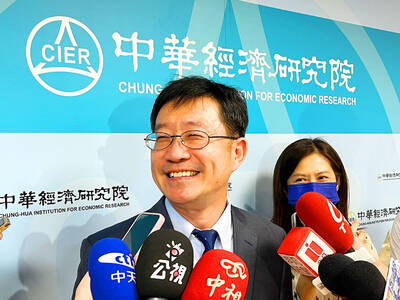Display driver IC supplier Novatek Microelectronics Corp (聯詠) yesterday said revenue this quarter would drop more than 10 percent sequentially, which it attributed to weak demand for consumer electronics, but should return to growth next year driven by new product launches.
The company expects its first organic light-emitting diodes (OLED) touch with display driver integration (TDDI) chips to enter volume production in the second quarter of next year, Novatek president Steve Wang (王守仁) told an online investors’ conference.
“We are cooperating with customers, including flat-panel makers and mobile phone vendors, to develop this product. The development is on track,” Wang said.

Photo: Grace Hung, Taipei Times
The company is likely to supply its new OLED TDDI chips to Apple Inc’s new iPhone series next year, local media reports said.
“With several new products scheduled to be introduced next year, Novatek believes that revenue should grow as a result,” Wang said.
Artificial intelligence-enabled smartphones, laptops and PCs are expected to stimulate replacement demand next year, but the outlook for consumer electronics remains uncertain, he said.
Novatek’s reported revenue in the first 10 months of this year shrank 7.28 percent annually to NT$86.05 billion (US$2.67 billion).
The company forecast that revenue this quarter would reach between NT$24 billion and NT$25 billion, compared with NT$27.87 billion last quarter, dragged by a decline in the company’s television chip business, Wang said.
Small and medium display driver ICs were the biggest revenue contributor last quarter, making up 42 percent. Large display driver chips came in next at 37 percent, with the remaining 21 percent coming from television chips.
“The recovery momentum in the overall consumer electronics segment remained weak in the fourth quarter, except for the smartphone segment,” Wang said.
“Demand for monitors and notebook computers also looks weak,” Wang added.
The company expects gross margin to drop to between 37 percent and 40 percent, compared with 39.74 percent last quarter, the lowest in three-and-a-half years, due to a less favorable product mix, rising gold prices and downward price adjustments for certain goods.
As the display driver IC industry enters its slow season this quarter, the company aims to enhance its cost control measures and upgrade product specifications to buoy gross margins, Wang said.
The company reported third-quarter net profit sank 17.4 percent year-on-year and was down 2.4 percent quarter-on-quarter to NT$5.36 billion. Earnings per share dropped to NT$8.64, compared with NT$10.46 a year ago and NT$8.86 the previous quarter.

WEAKER ACTIVITY: The sharpest deterioration was seen in the electronics and optical components sector, with the production index falling 13.2 points to 44.5 Taiwan’s manufacturing sector last month contracted for a second consecutive month, with the purchasing managers’ index (PMI) slipping to 48, reflecting ongoing caution over trade uncertainties, the Chung-Hua Institution for Economic Research (CIER, 中華經濟研究院) said yesterday. The decline reflects growing caution among companies amid uncertainty surrounding US tariffs, semiconductor duties and automotive import levies, and it is also likely linked to fading front-loading activity, CIER president Lien Hsien-ming (連賢明) said. “Some clients have started shifting orders to Southeast Asian countries where tariff regimes are already clear,” Lien told a news conference. Firms across the supply chain are also lowering stock levels to mitigate

Six Taiwanese companies, including contract chipmaker Taiwan Semiconductor Manufacturing Co (TSMC, 台積電), made the 2025 Fortune Global 500 list of the world’s largest firms by revenue. In a report published by New York-based Fortune magazine on Tuesday, Hon Hai Precision Industry Co (鴻海精密), also known as Foxconn Technology Group (富士康科技集團), ranked highest among Taiwanese firms, placing 28th with revenue of US$213.69 billion. Up 60 spots from last year, TSMC rose to No. 126 with US$90.16 billion in revenue, followed by Quanta Computer Inc (廣達) at 348th, Pegatron Corp (和碩) at 461st, CPC Corp, Taiwan (台灣中油) at 494th and Wistron Corp (緯創) at

NEGOTIATIONS: Semiconductors play an outsized role in Taiwan’s industrial and economic development and are a major driver of the Taiwan-US trade imbalance With US President Donald Trump threatening to impose tariffs on semiconductors, Taiwan is expected to face a significant challenge, as information and communications technology (ICT) products account for more than 70 percent of its exports to the US, Chung-Hua Institution for Economic Research (CIER, 中華經濟研究院) president Lien Hsien-ming (連賢明) said on Friday. Compared with other countries, semiconductors play a disproportionately large role in Taiwan’s industrial and economic development, Lien said. As the sixth-largest contributor to the US trade deficit, Taiwan recorded a US$73.9 billion trade surplus with the US last year — up from US$47.8 billion in 2023 — driven by strong

ASE Technology Holding Co (ASE, 日月光投控), the world’s biggest chip assembly and testing service provider, yesterday said it would boost equipment capital expenditure by up to 16 percent for this year to cope with strong customer demand for artificial intelligence (AI) applications. Aside from AI, a growing demand for semiconductors used in the automotive and industrial sectors is to drive ASE’s capacity next year, the Kaohsiung-based company said. “We do see the disparity between AI and other general sectors, and that pretty much aligns the scenario in the first half of this year,” ASE chief operating officer Tien Wu (吳田玉) told an